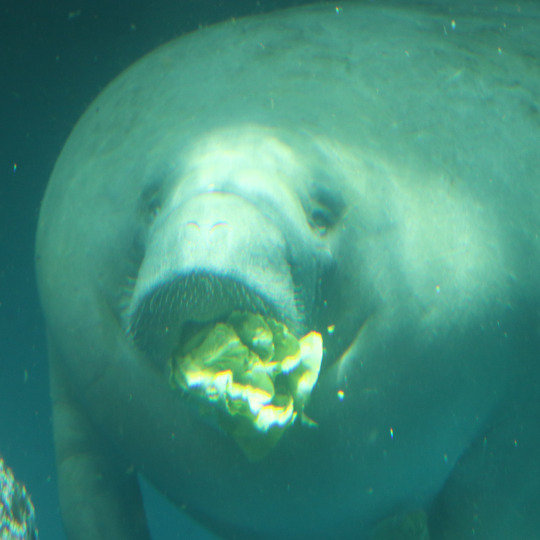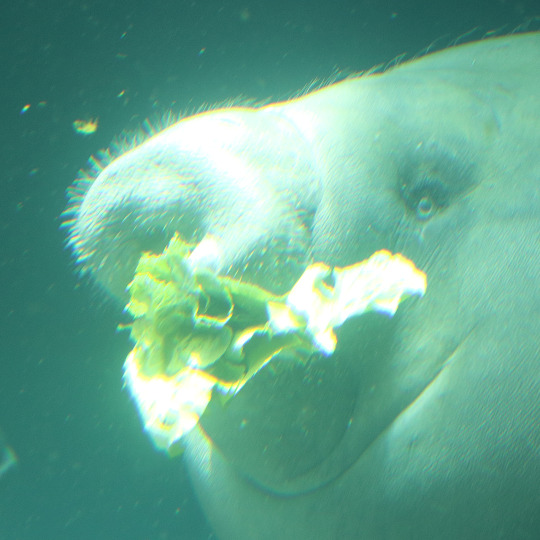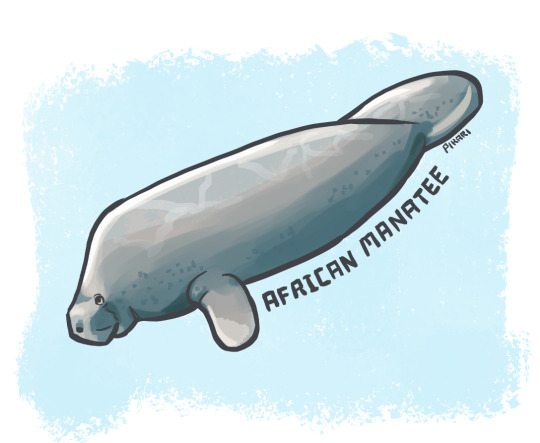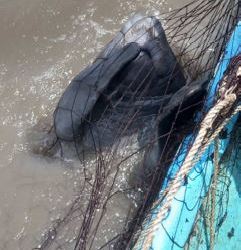#Trichechus senegalensis
Explore tagged Tumblr posts
Text





レタスがおいしいマナティーさん
しっぽにスッポンモドキをそえて
鳥羽水族館
She was eating lettuce with a turtle on her tail.
Toba Aquarium
#Trichechus senegalensis#アフリカマナティー#マナティー#African manatee#manatee#mammal#鳥羽水族館#スッポンモドキ#Carettochelys insculpta#Fly river turtle#reptile
716 notes
·
View notes
Text

West African manatee Trichechus senegalensis
Observed by eniangii, CC BY-NC
166 notes
·
View notes
Text
For #ManateeAppreciationDay:


1. original watercolor by Joseph Wolf (German, 1820-1899) for ZSL, 1879 via ZSL Library 2. published version, plate 7 in Biologia Centrali-Americana: Mammalia, 1879-1882 via BHL
More info via ZSL Library: "Watercolour on paper, in window mount ; art - 35 x 27 cm., mount - 57.5 x 44.5 cm. Signed by artist in black paint in lower right corner: 'J. Wolf. 1879'." "Mss title in ink and pencil, in unidentified handwriting, on label pasted on mount: 'Manatee (Manatus americanus) from a specimen living in the Westminster Aquarium 1879. See PZS 1879'."
"According to the caption the painting was made of an animal living in Westminster Aquarium. A manatee - said to be Manatus americanus - was living in the Westminster Aquarium in 1879 and a note about it by Dr James Murie was published in 'PZS' 1879 : 552. This refers to Murie's forthcoming paper on that manatee based on observations of the great mobility of the upper lip and use of the limbs in feeding when it was living in the Aquarium and brain structure (after it died). This paper was published : Murie, J. (1880) 'Further observations on the manatee', 'TZS' 11 : 19-48 5 pls (by C. Berjeau). On p. 21-23 Murie states the adult female manatee was caught in a net on the Dauntless Bank, off the Island of Lequana, near the mouth of the Essiquibo River, British Guiana, taken to London and purchased by the Aquarium in June 1878. It died on 15 March 1879. Wolf's painting is [therefore] presumably of the West African manatee, Trichechus senegalensis."
🆔Manatee, likely West African Manatee (Trichechus senegalensis); Kingfisher, likely Giant Kingfisher (Megaceryle maxima)
FYI, there are three living species of manatee, and Wolf's illustration has gone through the confusion of first being misidentified as one, then another, before finally being correctly recognized as the third! More info on the blog:
#animals in art#animal holiday#european art#19th century art#illustration#manatee#kingfisher#bird#birds in art#Giant Kingfisher#African Manatee#West African Manatee#BHL#ZSL#ZSL Library#book plate#lithograph#watercolor#painting#Joseph Wolf#natural history art#scientific illustration#species ID#Manatee Apprecation Day
31 notes
·
View notes
Note
manatee please? or naked mole rat
I've already done a post on a species and subspecies of manatee but I can totally do a naked mole rat! I hope my manatee posts will keep you busy until I find information on the adorable not-a-mole, not-a-rat, naked mole rat.
32 notes
·
View notes
Text

African Manatee (Trichechus senegalensis)
West African coast and rivers
Status: Vulnerable
Threats: dams, hydroelectric power, poaching, development
#drawing manatees is just like... *manatee shape* and then you're done#african manatee#artists on tumblr#animal art#marine mammals#manatee art#endangered species#oceans#illustration#blue aesthetic#huevember#ocean art#africa#west africa#mammal#manatee
22 notes
·
View notes
Text
Manatee Capture and Release: First Documentation in Rogolié River Wetland, Gabon

Abstract
A large number of marine mammals are seriously threatened by fisheries. Although the issue of by-catches in fisheries is a major threat to marine mammals, it has not yet been tackled in a concrete way in Gabon. Artisanal fishing accounts for 95% of fishing activity. Their impact on vulnerable megafauna can therefore be significant, either as bycatch or as target species. However, detailed information on the composition of fisheries catches is limited because of a lack of monitoring and reporting due to limited financial and logistical capacity. The aim of this paper is to document a rare phenomenon of the release of an African manatee (Trichechus senegalensis) caught in fishing nets at the mouth of the Rogolié River in the Gabon estuary.

Introduction
Of all sirenians species the West African manatee (Trichechus senegalensis) is the least well known biologically (Reynolds and Odell 1991). The species is considered vulnerable by the IUCN (Keith Diagne, 2015) due to the persistence of a wide range of threats, primarily of human-induced. This species occurs in most of the coastal marine waters, brackish estuaries, and adjacent rivers along the West African coast from southern Mauritania (16°N) to the Cuanza and Longa Rivers in Angola (9°S) (Dodman et al. 2008; Perrin 2001; Powell 1996; Grigione 1996; Nishiwaki 1984; Husar 1978; Robinson 1971; Blancou 1960; Beal 1939). Gabon may have one of the highest densities of Manatees remaining in Africa (Nkollo 2022; Powell 1996). The decline of the Trichechus senegalensis population has been largely attributed to hunting and incidental capture in fishing nets (Dodman et al. 2008; Blancou 1960; Cadenat, 1957).
Bycatch in fishing gear is also a major threat in all African countries, and even when caught alive, most manatees caught incidentally are not released, but killed (Nkollo 2017; Mbina 2001).
The aim of this note is to document the phenomenon of accidental captures and rescue efforts for the African manatee, a vulnerable species. We believe that the lessons learned from this event can be beneficial to manatee conservation stakeholders and can contribute to the development of better manatee release practices.
Source : Manatee Capture and Release: First Documentation in Rogolié River Wetland, Gabon | InformativeBD
2 notes
·
View notes
Text
African Manatee Trichechus senegalensis
In the folklore of West Africa, there’s a fascinating character called Maame Water, believed to be a goddess of the sea, she symbolises wealth and …African Manatee Trichechus senegalensis

View On WordPress
0 notes
Photo

Sirens of the Sea
Here’s something different; not cetaceans, but marine mammals for sure. A fun challenge from one of last year’s commission. Definitely a ways outside of my normal comfort zone, but I think they turned out okay. (Dugong and Manatee experts will no doubt be able to spot some blaring mistakes lol). I especially enjoyed painting the Dugong. Very weird, but cute at the same time. And their heads have a nice shapeliness to them. That’s nice for drawing. The manatee by contrast felt a bit more “blobby” and hard to make look right. I hope you’ll like these two Sirens - the order’s scientific name coming from a legend regarding their discovery: lonely sailors would have mistaken them for mermaids, like the sirens of Greek Mythology.
We’re almost through the (rather huge) list of illustrations from last year’s commissions by the way. Just baleen whales to go - and then..? I’m not sure because I still haven’t painted anything this year. A bit appalling how busy things stay. Hopefully soon.
#scientific illustrations#illustrations#Dugong#Dugong dugon#West African manatee#manatee#Trichechus senegalensis#sirenia#sirenians#sirens#marine mammals#digital art
81 notes
·
View notes
Text

This stamp was issued in 1962 by the Republic of Niger. It was meant to promote the protection of local wildlife, and features an engraving of a manatee (or 'lamantin,' in French), created by the French stamp engraver, Jacques Combet. Combet designed engravings for many stamps in this time period, but was said to prefer images depicting nature. The African manatee (Trichechus senegalensis) resides throughout much of West Africa, and its conservation status is currently classified as a vulnerable species.
#philately#stamp collection#stamp of the day#wildlife#animal conservation#snail mail#postage stamps#stamps#stamp collecting#niger
30 notes
·
View notes
Link

Abstract
This study aims to improve knowledge on the distribution and status of West African manatee (Trichechus senegalensis) in Niger in order to identified the main threats facing the manatee in its distribution area and to promote its sustainable management. It was carried out on the Nigerien portion of the Niger river from its entry into the territory from Koutougou (department of Ayorou) on its exit in Dolé (department of Gaya). The method consisted of socio-economic surveys and identification of feeding indices. The abundance of feeding signs and manatee parts (bones, skin, smoked meat, etc) showed that presence of the species. This study revealed the existence legal texts which confer to the manatee integral protection in Niger and this in disfavor of the local population who could no longer fish. However, human threats coupled with the effects of climate change are the greatest challenges to the conservation of the species. This study showed that manatee occupies an emblematic place in the traditions of the populations which could contribute in the elaboration of efficient conservation strategy for the survival of the manatee.
Get the original articles in Source: Distribution and status of West African manatee (Trichechus senegalensis) in Niger
Journal Name: Journal of Biodiversity and Environmental Sciences (JBES)
Published By: International Network for Natural Sciences
4 notes
·
View notes
Text
Evolución del Manatí

El descubrimiento de la evolución de algunos animales puede ser sorprendente, debido a sus características curiosas.
El manatí, tiene una historia de vida en el planeta Tierra que es tan interesante como la de otros animales. este animal es un mamífero herbívoro que vive a pocas profundidades, mayormente se establece en lugares pantanosos. La familia Trichechidae, genero Trichechus que forman parte del orden Sirenia, son conocidos normalmente como manatíes o vacas marinas.
Aunque la información sobre dichos mamíferos, según el científico Roger Reep, de la Universidad de Florida, en síntesis menciona que la evolución de los manatíes provine de un mamífero herbívoro parecido al cerdo, que con el paso del tiempo tuvo que haberse adaptado debido a las necesidad que requería para sobrevivir, en este caso la adaptación a un mundo acuático.
El manatí tras un cambio logró adquirir las características que posee actualmente, como aumentando su tamaño, para facilitar la reserva de calor, y además su proceso metabólico fue aún más lento para no perder tanta energía y le proporcione su desplazamiento.
Lo más curioso de la evolución de los manatíes es que sus parientes más cercanos son los elefantes. Aunque no encuentres mucha semejanza entre un mamífero marino con aleta y un enorme mamífero terrestre de cuatro patas, se han realizado análisis bioquímicos que arrojaron resultados increíbles: los sirenios guardan semejanzas con los elefantes, los damanes y los cerdos hormigueros.
Existen tres tipo de manatíes estos son:
Manatí antillano (Trichechus Manatus): el manatí antillano es el más grande que existe en el mundo, también se le conoce con los nombres de manatí del Caribe o manatí de Florida.
Manatí amazónico (Tichechus Inunguis) : este manatí solo habita en aguas dulces, generalmente puede encontrarse en lagos y lagunas.
Manatí de África (Trichechus Senegalensis): el manatí africano es la especie de la que menos información se tiene, de hecho, es difícil hasta conseguir fotos de este animal.

Los tipos de manatíes mencionados se encuentran dentro del orden Sirenia, al igual que los dugongos. Pero la diferencia de éstos, pertenecen a la familia Trichechidae y al género Trichechus, así que son llamados triquéquidos en el lenguaje científico.
Referencias
Swatman, R. (2015). Evolución del Manatí. Manatee-World. Recuperado de: https://www.manatee-world.com/evolucion-del-manati/
1 note
·
View note
Text
Animal of the Day!
West African Manatee (Trichechus senegalensis)

(Photo from New College of Florida)
Conservation Status- Vulnerable
Habitat- Coastal Western Africa
Size (Weight/Length)- 450 kg; 3.3 m
Diet- Aquatic grasses; Mangrove roots; Clams
Cool Facts- West African manatee prefer brackish water or freshwater rivers near the coast. They often spend the majority of their time in mangroves just off the coast. Like their American cousin, African manatees are mostly herbivores but they will eat a clam or two when given the opportunity. They live in small groups and are mostly active during the night to avoid predators, such as sharks and crocodiles. Individuals in a group form life long bonds, using touch, smell, and verbal communication. Due to threats from boat strikes, hunting, and damming of rivers, conservationist are hard at work protecting these gentle giants. Large areas of wetland are protected and organizations are hard at work educating people on the importance of West African manatees.
Rating- 13/10 (Underwater cows, how can they not be cute?)
#Animal of the day#Animals#Mammals#Manatee#Monday#February 21#West African manatee#biology#science#conservation#the more you know
69 notes
·
View notes
Text
Cientistas brasileiros identificam espécie de peixe-boi extinta há 40 mil anos
Pesquisadores brasileiros identificaram uma espécie de peixe-boi que desapareceu há cerca de 40 mil anos. O Trichechus hesperamazonicus viveu no trecho do rio Madeira que passa pelo estado de Rondônia, onde hoje não vive nenhum animal do mesmo gênero.
Foto: Reprodução
O fóssil foi encontrado no final dos anos 1980 por garimpeiros nas margens do rio, mas a descoberta da espécie foi feita só agora, com a análise mais profunda do material -uma mandíbula e um pedaço do crânio- realizada por pesquisadores da Universidade Federal de Minas Gerais (UFMG) e do Museu Estadual de Rondônia.
O achado foi publicado no periódico norte-americano Journal of Vertebrate Paleontology no início deste ano.
Desde que os vestígios do bicho foram encontrados, os cientistas sabiam que se tratava de um peixe-boi pelas características que marcam os animais, como a série dentária contínua, explica Fernando Perini, biólogo e professor da UFMG que participou dos estudos.
Nas espécies de peixes-boi, os dentes são constantemente repostos. Dentes novos vão surgindo na parte de trás da mandíbula e empurram os dentes mais velhos e desgastados para fora da boca. Um traço bastante raro entre os animais.
Apesar de viver na água, o peixe-boi não é um peixe -é um mamífero aquático. Existem, atualmente, três espécies diferentes viventes: o marinho (Trichechus manatus), que é encontrado na Flórida (EUA), costa do Caribe e costa brasileira; o amazônico (Trichechus inunguis), que vive no rio Amazonas, nos estados do Pará e Amazonas; e o africano (Trichechus senegalensis), que vive nos rios e na costa ocidental da África.
O hesperamazonicus, ou peixe-boi do oeste da Amazônia, é a primeira espécie fóssil de peixe-boi descrita na literatura científica.
“Ao compararmos, vimos que esse animal não se encaixava entre as outras espécies conhecidas, apesar de ter algumas características em comum com elas”, diz Perini.
A espécie extinta possuía uma boca virada para frente, assim como o peixe-boi amazônico, o que facilita a coleta da vegetação que flutua no rio. Mas, no hesperamazonicus, os dentes eram voltados para dentro e há um espaço maior entre a mandíbula e arcada dentária. Segundo Perini, isso sugere que a musculatura nessa área era maior e mais reforçada do que nas espécies viventes.
“Uma maior musculatura nessa região pode estar relacionada ao tipo de vegetação que o animal consumia. Se era mais fibrosa, ele precisava de um esforço maior para mastigar o alimento”, explica o biólogo.
O animal vivia em lagos ou rios calmos, assim como seus parentes modernos. De acordo com Perini, uma mudança no regime das águas na região pode ter contribuído para a extinção da espécie.
Hoje, o rio Madeira tem águas velozes, incompatíveis com as características do peixe-boi. “A região amazônica tem passado por mudanças nos regimes de rios nos últimos milhões de anos, é um ambiente dinâmico”, diz Perini. “A mudança na elevação dos Andes ou outras mudanças topográficas transformaram rios mais calmos em cursos de água mais caudalosos”, afirma.
Mudanças climáticas ao longo de milênios podem também ter colaborado para a extinção do hesperamazonicus.
Segundo o pesquisador, a história dos peixes-boi ainda é pouco conhecida, mas a descoberta fornece novas pistas para entender a trajetória dos animais. Umas das possibilidades cogitadas pelos cientistas é que a mudança no regime dos rios pode ter isolado bichos de uma mesma espécie em dois lugares diferentes e, com o isolamento, aconteceu a especiação -processo pelo qual uma única espécie dá origem a outras.
Uma das versões aceitas pela comunidade científica é a de que os peixes-boi chegaram aos rios brasileiros por uma invasão pelo mar. Com o conhecimento sobre a espécie fóssil, surge a possibilidade de terem sido duas invasões, na verdade. “O que sabemos é que é muito provável que essas espécies tenham existido todas ao mesmo tempo em algum momento”, diz Perini.
O post Cientistas brasileiros identificam espécie de peixe-boi extinta há 40 mil anos apareceu primeiro em PIRANOT.
0 notes
Link
1 note
·
View note
Photo



Happy Manatee Appreciation Day, world! This stamp enthusiast has fond memories of walking to the Matanzas River by Grand-mère’s house in Florida to coo at the sea cows curiously bobbing up to say moo. I sure hope that won’t be a reminiscence impossible for future generations to recall.
Stamp details: Stamp on top: Issued on: September 5, 2008 From: Brasília, Brazil MC #3565
Bottom left: Issued on: March 22, 1988 From: Amsterdam, Netherlands MC #1340
Bottom right: Issued on: June 20, 1998 From: N'Djamena, Chad MC #1721
#Manatee Appreciation Day#Trichechus inunguis#Trichechus manatus#Trichechus senegalensis#amazonian manatee#west indian manatee#west african manatee#manatees#manatee#sea cow#american manatee#african manatee#stamps#philately#march 28#netherlands#nederland#chad#brazil#brasil#تشاد#tchad#endangered species
6 notes
·
View notes